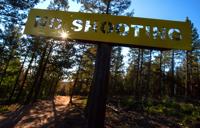Debate continues over the U.S. Forest Service's mission to control recreational shooting across public lands close to Front Range populations.
It's been an ongoing debate for about three years now, ever since officials launched a project called "Integrated Management of Target Shooting on the Pike National Forest." The project has garnered standing-room-only meetings and hundreds of comments from impacted people in El Paso, Douglas, Teller and Park counties.
While target shooting is a valid, historic activity across national forests, Pike's land managers have reported rising numbers of shooters, campers, hikers, bikers, off-roaders and other outdoor enthusiasts converging in an unsafe way. Stray bullets and close calls have been reported over the years, along with increased trash, shot-up trees and wildfire sparks.
Make a plan for otherworldly stargazing at Colorado's Great Sand Dunes
"Because of the increase of use in the forest overall ... we've hit a point where (target shooting) is no longer a sustainable recreation activity the way we manage it now," Jennifer DeWoody, the Forest Service's project leader, said at a recent meeting.
The meeting was part of a series that presented possible strategies.
The proposal: to outlaw gunfire in about 72% of Pike National Forest and build at least one shooting range in each of the Pikes Peak, South Platte and South Park ranger districts. While three ranges would be the minimum, officials say up to nine could be built over time.
The same numbers apply to an alternative strategy that would ban dispersed shooting across closer to 59% of the forest instead of 72%. The final alternative presented was a "do-nothing" approach, with shooting bans limited to those already ordered in areas deemed unsafe. (Maps of the alternatives are posted on a project webpage: tinyurl.com/2s3jat5x)
The Forest Service's latest presentations came with a report summarizing some 1,667 comments received over the past few years. Many comments regarded those vast closures. Officials say the areas were identified for their "high use" by people, posing safety risks, and/or proximities to homes, roads and streams.
Forest Service adds nearly 130 acres of public land in Pikes Peak region
The proposed closures "represent a 'power grab' by the federal agency,'" read one summarized comment. "The public should be able to enjoy public lands without restrictions (or with few restrictions)."
To other comments claiming Second Amendment rights, the Forest Service responded: "The proposed action and alternatives do not infringe on an individual's right to keep and bear arms, rather it delineates how target shooting will be managed on the Pike National Forest ..."
The agency has also heard concerns about unintended consequences.
Perhaps closures "will increase impacts at those areas remaining open, making people go to more remote areas," read one comment. Others have worried about a "funnel effect" — shooters pushed out of the forest and crowding the designated ranges.
Of particular interest is the popular shooting ground known as Turkey Tracks, near the Teller-Douglas county line north of Woodland Park. While some know the site as dangerous — including homeowners who have reported close calls — the Forest Service has proposed rearranging the site and building it up as a range to meet its standards.
Said one nearby enthusiast with the local gun club, Jerry Smith: "It's going to have to be maintained, monitored full time. If you just leave it like it is now and build a range, I still would not want to go there."
While wondering about specifics, Smith praised the Forest Service's attempts to address dispersed shooting and echoed some first responders over the years: "It's just gotten out of hand."
From feedback over the years, "half wanted no oversight and half wanted oversight," Andy Hough said. He leads the multi-agency Southern Shooting Partnership that has worked alongside the Forest Service on a plan.
There have been split opinions, too, about fees at the ranges — seen by some as the only way to afford potential oversight and upkeep. The Forest Service has emphasized an "adaptive strategy," whereby management could be adjusted.
Idaho Springs' new golden opportunity: scenic gondola and 'world-class' mountain biking
Initially, "the general philosophy of this is to manage these (ranges) by doing the least amount of heavy-handed management techniques," Pikes Peak District Ranger Carl Bauer said at a recent meeting.
That does little to quell fears of nearby homeowners, who expressed themselves during the series of presentations.
South Platte District Ranger Brian Banks said he sympathized with them. "The reality of living in an urban forest is, there is no place away from everybody," he said. "There is no perfect, pardon the pun, silver bullet."
Hough has sought to quell fears by emphasizing the precise engineering and safety components of the proposed ranges. He has called them "idiot-proof," adding: "In my optimistic world, we are going to build such good ranges that a number of dispersed shooters are going to want to shoot at these facilities."
The Southern Shooting Partnership has $400,000 at the ready to start building, Hough said — in place of the Forest Service, which cannot pursue funding "until a final decision is issued and/or litigation is solved," Hough noted.
Comments can be filed through Sept. 4 on the "Integrated Management of Target Shooting" project webpage. A final decision could come in early 2025.






